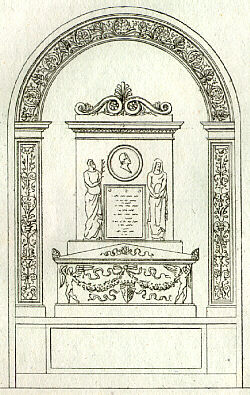
Beccadelli Giacomo Ottavio
| |
1998.10.02
Grubbtown Civil War Memorial
1998.10.30
Memorial Hall
1876
Civil War Memorial
1912
2001.09.09 13:34
Re: architexturalizing
I suggest anyone interested in damnatio memoriae (a specific type of censorship) read History and Silence, by Charles W. Hedrick, Jr. (2000). Here are some of the chapter titles: "Remembering to Forget"; "Silence, Truth and Death"; "Rehabilitating the Text"; and "Silence and Authority".
In "Remembering to Forget" one learns that damnatio memoriae actually did more to make people remember than it did to make them forget. Officially and literally, the memory was erased, however, the act of erasure itself, like the scar that it is, only reinforces the real reality that once was. Yes, erasures ironically are very full of meaning...
| |
2001.10.19
Widener Memorial Tree House Children's Zoo 1984a
2002.11.15
Civil War Soldiers and Sailors Memorial
2002.12.17 17:25
Re: a Bemused Tadao Ando observation
I have studied the evolution of Kahn's architecture beyond Kahn since my own architecture thesis 1981, and Ando's Museum of Literature design appears to be a late descendant of Kahn via late 1970s Stirling and early 1980s Isozaki.
Kahn's Levy Memorial Playground designs with Isamu Noguchi (1961-66, unbuilt), and his Dominican Motherhouse of Saint Catherine de Ricci (1965-69, unbuilt) engendered much formal architectural play, a genealogy that goes mostly unnoticed by architectural historians. Much of Predock's, work, for example, especially "reenacts" the Levy Memorial Playground designs.
Interesting how you relate the Museum of Literature to a kind of themepark. It could easily be said that Kahn's formal playfulness was inspired by Piranesi's Ichnographia Campi Martii, an ultimate plan of an ancient Roman themepark if there ever was one.
| |
2002.12.27 13:47
Re: WTC design reflections
While religion might be for the most part absent from thinking about the site now (officially at least), the notion of worship is nonetheless still present. I wonder how many houses of worship the WTC site could comfortably accommodate among the rest of what is (commercially and commemoratively) proposed. Do any of the new proposals specifically address pilgrimage? Or is pilgrimage only something (to be) attached to the forthcoming memorial proposals?
There are memorials everywhere all over this planet, and, unfortunately, most are soon and easily forgotten--when's the last time you went specifically to an old memorial to specifically remember what is there being memorialized? There are comparatively few memorials on this planet that are pilgrimage sites as well.
2003.02.04 11:50
Re: Robert Venturi
I'm beginning to see a lot of Venturi et al architecture and design as 'mod'. Not Modern, not Post-Modern, not (just) Pop--specifically mod.
The Princeton Memorial Park tower is very mod, as is the Mr. and Mrs. Gooding house of a decade later.
Venturi, like Stirling, is a mod colorist (for sure), a distinct rarity within 20th century architectural history.
| |
2003.12.03 17:36
so much for liberty...
The point of this thread is... ...the ironic symbolism currently manifest by the architecture at Independence Historic National Park.
Security checkpoints at IHNP are a post-911 phenomenon, and, as far as their 'design" there goes, they are makeshift and poorly executed. Using the former Liberty Bell Pavilion now also as a checkpoint adds symbolic absurdity to the mix.
Granted this may all be temporary, but, if you are mindful of all the 200+ year history of this specific site, there's not much about it that hasn't just been temporary, or indeed ironic about the literal birthplace of the United States of America.
Perhaps the reason it is so difficult these days to design a decent memorial is because architects for almost a century now are more trained at designing oblivion.
2003.12.14 17:42
Re: which Acropolis do you prefer?
The explosion of the Parthenon occurred 26 September 1687. It would be interesting to know how many people on Earth 316 years from now will know the date of the attack on the World Trade Center off the top of their head.
Collective memory is a lot more selective than criticism.
For how long did the 'ideal' design of the Acropolis actually exist? Moreover, do we even fully understand what the Acropolis was really like while it manifest it's most ideal existence. For example, how was it all painted? Did a fair amount of the ideal design actually fade as soon as the colors did?
|